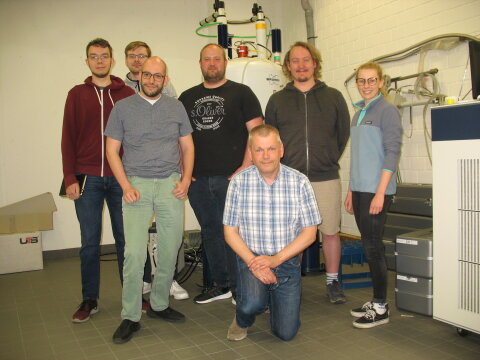Report to the 20. DMG Shortcourse "Applications of Solid State NMR Spectroscopy in the mineralogical and geoscientific research "
in Bochum from 30. May - 02. June 2023

Also, this year, a short course on NMR spectroscopy was organized by the DMG/DGK. Under the direction of Dr. Michael Fechtelkord, participants from a wide variety of disciplines (e.g., cement chemistry, petrology or chemical engineering) were able to deal in detail with the analytical possibilities of solid-state NMR spectroscopy.
This course offered PhD students and scientific staff the interesting opportunity to combine a repetition of the physical basics of the methodology with practical examples, or to get a comprehensible introduction to NMR spectroscopy. While the theoretical foundations and plans for the day were worked out in the morning, the afternoon was devoted to practical work. In addition to the preparation of samples to be measured, the course participants were even able to carry out measurements on the device themselves.
Using the example of the 1H spin lattice relaxation of tetramethylammonium iodide and the calculation of activation energies and correlation times for the discovered relaxation signals of the ammonium and methyl environments, it was also shown how strong the influence of the experiment temperature can be on the NMR spectra obtained. The course day ended with drinks and food in the "Filou" pub, where the participants got to know each other better.
The next day, dipolar and chemical shift interactions were presented and their influence on the spectra obtained was explained. We were able to determine that e.g., signals from the sample cannot be easily distinguished from rotating sidebands and impurities. Here the evaluation software DMFit2020 proved to be a very helpful tool. As in the history of NMR spectroscopy, Wednesday afternoon marked a crucial turning point in the course. The removal of anisotropy effects using Magic Angle Spinning (MAS) probe heads opened up completely new analytical possibilities. This technique was used in the practical part to study 29Si, 19F and 1H nuclei in synthetic phlogopites. It clearly showed that NMR spectroscopy is excellently suited as a complementary technique to diffraction methods and is of particular interest when doping or naturally “contaminated” minerals are to be observed and their structural peculiarities are to be elucidated.
The third day of the course dealt with the possible applications of multi-pulse techniques and the basics of the cross-polarization experiment (CP). In the practical part, a contact-time dependent CPMAS experiment was performed on kaolinites. Subsequently, atomic distances between Si and H nuclei were determined. This could be done with a simple spreadsheet.
The last day was dedicated to the quadrupolar nuclei (spin quantum number I > 0.5). As examples, the muclei 23Na and 27Al were measured and analyzed in different salts and corundum.
In the theoretical part, the focus was on other NMR methods such as "Double Rotation" (DOR) or Multi-Quantum Magic-Angle Spinning (MQMAS) and Satellite Transition Spectroscopy (SATRAS). At this point, at the latest, it became clear that it would take four years rather than days to understand all solid-state NMR methods and to be able to apply them in practice.
However, there was enough time to develop a general idea for the different approaches and to understand which information can be obtained with which method. In general, it can be said that the overview given is very helpful for planning future projects and for evaluating scientific questions that have already been asked.
Christian Felten, Henning Kruppa, and Michael Wenzel
RWTH Aachen


